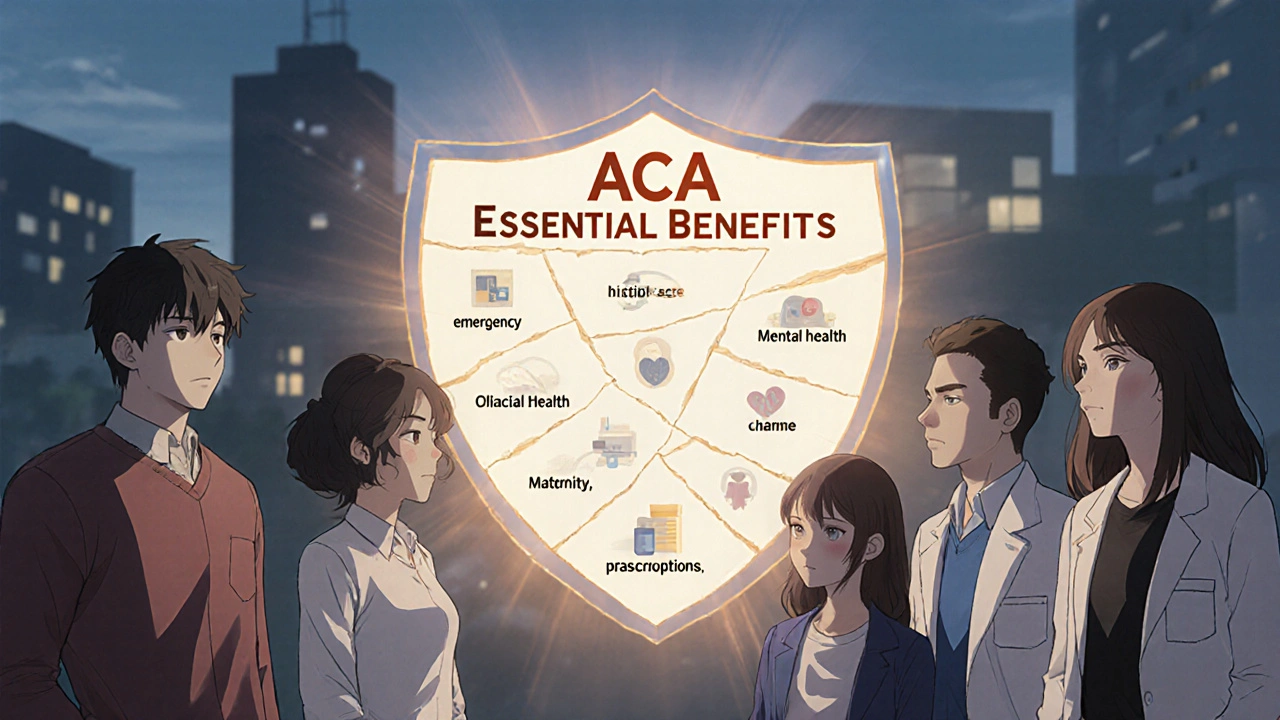ACA Plans and Generic Coverage: What You Actually Get Under the Affordable Care Act
 Nov, 20 2025
Nov, 20 2025
When you hear ACA plans, you might think of cheap health insurance. But what you actually get? That’s where things get real. The Affordable Care Act didn’t just make insurance more affordable-it changed what insurance even means. Before 2010, if you had diabetes, cancer, or even asthma, insurers could deny you coverage or charge you triple. Now? They can’t. That’s not a perk. That’s a lifeline.
What’s Included in Every ACA Plan
Every ACA Marketplace plan-whether it’s Bronze, Silver, Gold, or Platinum-must cover ten essential health benefits. No exceptions. No fine print loopholes. These aren’t optional add-ons. They’re the baseline. That means:
- Ambulatory patient services (outpatient doctor visits)
- Emergency care
- Hospitalization
- Pregnancy, maternity, and newborn care
- Mental health and substance use disorder services
- Prescription drugs
- Rehabilitative and habilitative services
- Laboratory services
- Preventive and wellness services
- Pediatric services, including dental and vision
If your plan doesn’t cover one of these, it’s not an ACA plan. Period. And that’s the point. Before the ACA, insurers sold plans that looked cheap but skipped everything important-like maternity care or mental health. People ended up with bills they couldn’t pay because their plan didn’t cover what they needed. The ACA fixed that.
How Premium Tax Credits Actually Work
Most people don’t pay full price for their ACA plan. They get help. That help is called a premium tax credit. It’s not a discount you apply at checkout. It’s money sent directly to your insurer to lower your monthly bill.
Right now, if your household income is between 100% and 400% of the Federal Poverty Level (FPL), you qualify. For a single person in 2025, that’s $15,060 to $60,240 a year. If you make $50,000, you could pay as little as $247 a month for a Silver plan-with enhanced credits. Without them? $534. That’s not a small difference. That’s $3,456 a year you don’t have to spend.
But here’s the catch: those enhanced credits expire at the end of 2025. If Congress doesn’t act, your premium could jump by over 100% next year. For a 60-year-old in some states, it could be nearly double. That’s not a policy tweak. That’s a financial earthquake for millions.
Metal Tiers: Bronze, Silver, Gold, Platinum
Don’t be fooled by the names. Bronze isn’t cheap because it’s bad-it’s cheap because you pay more when you use care. Silver is the sweet spot for most people, especially if you qualify for cost-sharing reductions (CSRs). Those are extra discounts on deductibles and copays that only apply to Silver plans.
Here’s the breakdown:
| Plan Tier | Actuarial Value | What You Pay | Best For |
|---|---|---|---|
| Bronze | 60% | 40% of costs | Healthy people who rarely see doctors |
| Silver | 70% | 30% of costs | Most people-especially if you get CSRs |
| Gold | 80% | 20% of costs | People who use care regularly |
| Platinum | 90% | 10% of costs | Chronic conditions, frequent hospital visits |
Most people who get subsidies pick Silver. Why? Because if your income is below 250% FPL, you get extra help lowering your out-of-pocket costs-like lower deductibles and copays. That’s called a cost-sharing reduction. It’s not automatic. You have to pick a Silver plan to get it.

Who Gets Left Out?
Not everyone qualifies. DACA recipients were eligible until November 2025. Now, they’re not. That’s about 550,000 people losing coverage. It’s not a loophole-it’s a policy change. And it’s not just about paperwork. It’s about people who’ve been paying taxes, working, and raising families suddenly losing access to care.
Also, if you’re over 400% FPL and don’t get insurance from your job, you get no subsidy. That’s the “subsidy cliff.” Make $1 more than $60,240 as a single person? Your premium jumps from $300 to $800 a month overnight. No warning. No grace period. That’s why so many people are stuck between jobs or working gig work-they’re terrified of crossing that line.
The Enrollment Trap
Applying for an ACA plan sounds simple. It’s not. You need your Social Security number, pay stubs, tax returns, and proof of citizenship or immigration status. If you’re self-employed? You need bank statements, profit/loss statements, and sometimes even invoices. The system asks for your Modified Adjusted Gross Income (MAGI). Most people don’t know what that is.
And here’s the kicker: your subsidy is based on what you estimate your income will be. If you’re wrong? You pay the difference at tax time. One Reddit user, u/ACA_Warrior, got hit with $2,800 in unexpected bills because his income dropped mid-year and he couldn’t adjust his subsidy until next April. That’s not a glitch. That’s how the system works.
The new 2025 CMS rule tries to fix this by requiring quarterly income updates starting in 2026. That’s good. But it’s also a burden. If you’re a freelancer with fluctuating income, you’ll need to log in every three months and update your numbers. Miss one? Your subsidy could disappear.

Why ACA Plans Are Still the Best Option for Millions
Yes, the system is messy. Yes, the rules change. Yes, you can get hit with a tax bill if your income shifts. But here’s what no one else offers: guaranteed coverage for pre-existing conditions. No lifetime caps. No annual limits. Coverage for mental health and addiction treatment that actually matches physical health benefits.
Compare that to short-term plans-those “cheap” alternatives that exclude everything. Or employer plans that leave your family out because of the “family glitch” (which was fixed in 2023, but most people still don’t know about it). Or Medicaid, which is better-but only if you’re under 138% FPL.
For a freelance writer in Ohio making $32,000 a year? She gets a $0 premium Silver plan with full cost-sharing reductions. That’s not luck. That’s policy. That’s the ACA working exactly as designed.
What’s Coming in 2026
If the enhanced tax credits expire, the Marketplace will shrink. The Kaiser Family Foundation predicts a 15-20% drop in enrollment. Premiums could jump 25-35% in the first year. Older adults, low-income families, and people in non-expansion states will be hit hardest.
And the new rules? They’re tightening verification. You’ll need to prove your income more often. Your eligibility might be checked against IRS data more aggressively. That’s meant to stop fraud. But it also means more people will get dropped-accidentally-because of a mismatched W-2 or a late tax filing.
What’s clear? The ACA isn’t perfect. But it’s the only system that gives real protection to people who need it most. The alternatives? They’re not better. They’re just cheaper on paper. Until you get sick.
What You Should Do Now
If you’re enrolled in an ACA plan:
- Check your income estimate. If you’ve had a change-job loss, raise, new baby-update it now. Don’t wait until tax season.
- Make sure you’re on a Silver plan if you qualify for cost-sharing reductions. That’s where the real savings are.
- Know your out-of-pocket maximum. For 2025, it’s $9,450 for an individual. No plan can charge you more than that in a year.
- Start saving for 2026. If subsidies expire, your bill could double. Set aside $100 a month now to cover the gap.
- Don’t cancel your plan just because you think you can find something cheaper. Short-term plans and health sharing ministries aren’t insurance. They won’t cover your cancer treatment.
The ACA isn’t about politics. It’s about whether you can get care when you need it. Right now, 17.3 million Americans rely on it. For most, it’s the only thing standing between them and financial ruin.
